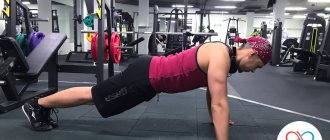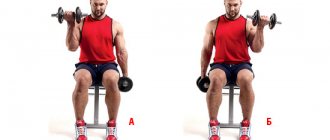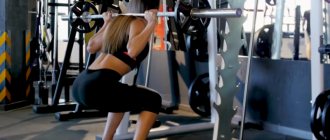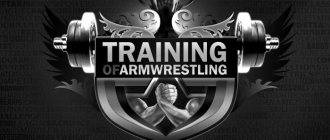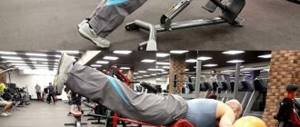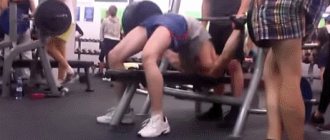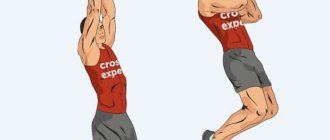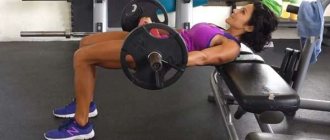What are negative pull-ups?
Negative pull-ups are understood as one of the variations of the technique of performing a classic exercise. The traditional version always consists of two phases in the form of rising and falling at the same pace. Negative pull-ups on the horizontal bar involve creating an emphasis on the second phase, when there is a slow return from the top to the bottom point.
This pulling technique allows you to additionally load the muscle fibers. A similar technique can often be seen in the training programs of professional athletes, and the effectiveness and benefits of negative pull-ups are recognized throughout the world.
What are the benefits of exercise?
Any pull-up technique involves a large number of muscles, and including them in a training program allows men to get a wide, powerful back and a V-shaped silhouette. They provide a natural load, which occurs due to the natural trajectory of movement. The technique is considered the least traumatic, as it uses your own body weight.
The technique is optimal for use in supersets and for adjusting loads in training programs.
The problem with traditional techniques is often that over time the body gets used to the stress and the benefits of training decrease. To maintain progress, athletes are forced to resort to various variations:
- changing the number of approaches and repetitions;
- use of weights;
- changing grip width.
One effective way to ensure greater load during training is to include negative pull-ups on the horizontal bar in your training program. Depending on the technique used, emphasis is placed on different muscle groups:
- reverse grip - when placing your palms towards your face, the biceps are worked out perfectly;
- one-handed version - hanging is done on one hand, using the abs and core fibers;
- counterweights - involves the use of a block simulator;
- wide placement of the arms - performed with the palms spread wider than the shoulders, allowing maximum load on the latissimus muscles in the back;
- hand lock - the muscles of the forearm work hard.
By varying the grip width you can change the load on certain areas to a greater or lesser extent. Any of the presented methods can be an additional incentive to activate the process of progression of muscle mass growth.
Pull-ups should be one of your core exercises. If for some reason you cannot visit the gym, pull-ups on the horizontal bar will help you stay in shape.
So what are the benefits of pull-ups? This exercise helps to significantly develop your back muscles. In addition, by pulling yourself up, a person develops many other muscles, indirectly working out the entire upper half of the body. All you need for pull-ups is a horizontal bar or bar. There are horizontal bars in almost all gyms and outside in courtyards and sports fields. It is not difficult to equip a horizontal bar at home.
You won’t be able to gain weight with pull-ups, but with their help, not only the back muscles, but also the arm muscles are perfectly strengthened and stretched.
The pull-up technique is very simple and accessible to absolutely everyone. But as I have seen, many people, training in gyms, have absolutely no idea about it. In short, the theory is this: the wider your grip on the bar, the more stress is placed on the latissimus dorsi muscles; The narrower the grip, the greater the load placed on the biceps. If you pull yourself up, touching the bar with the back of your head, the latissimus muscles stretch in width. And if you pull yourself up, touching your chin, then the lats also stretch into thickness. With a narrow grip, with your palms facing you, the lower part of the lats, located in the waist area, receives additional load.
I advise you to include pull-ups in your training program from the very first workouts. The grip should be used wider than the shoulders, so the load will fall more on the back muscles. Pull-ups are the only exercise where I allow myself to do up to six sets. Do as many pull-ups as you can on each set. Perform the first approach (warm-up) with a medium grip - slightly wider than shoulder width, until your chin touches the bar. Perform subsequent approaches with a wide grip, pulling yourself up until the back of your head touches the bar. On average, you should be able to do at least 10-12 repetitions in the first two sets, followed by a decrease in the number of repetitions per set. Pauses between approaches should not exceed 1.5 minutes. It is enough to include pull-ups in one workout per week. And once a month, do pull-ups touching the bar not with the back of your head, but with your chin. For variety, you can start doing a pull-up approach until the back of your head touches the bar, then the last two or three repetitions until you touch the chin, and after that, without stopping, perform another couple of pull-ups with a narrow grip, palms facing you.
You need to pull yourself up calmly, without jerking, at a pace that is comfortable for you. When lowering, you should not throw your body down, and you should also not strongly resist lowering to the lowest point. You need to lower your torso under control, mostly under your own weight. When the torso is at the lowest point, the arms should be completely straightened. Don’t forget about breathing: when you go down, inhale; pull yourself up - exhale.
Some athletes perform pull-ups with a weight attached to their belt, thereby giving themselves additional stress. I think this is an amateur job. I myself rarely hang a load on my belt; I like to just pull myself up. Some athletes use wrist straps to secure their hands more firmly to the bar. I also use wrist straps, but I try to do this as rarely as possible and resort to wrist straps mainly in the last, finishing approaches.
In addition to the latissimus dorsi muscles, pull-ups are a great stretch for the biceps and forearms, and also strengthen your hand grip. Many people are not aware of the role pull-ups play in building biceps. Meanwhile, during pull-ups, the biceps receive a good stretch, especially in the area of the elbow joint, which is most often problematic for many athletes. In addition, the biceps receives excellent development in width, forming a wonderful ball when bending the arm at the elbow. Let me remind you that you cannot gain weight in your biceps by doing pull-ups, but it is quite possible to achieve a neat and balanced shape.
Pull-ups are also valuable because they can replace a full workout when you don’t have time for it, or when you are far from the gym. Often when I am forced to skip workouts, I still strive to at least do pull-ups, thereby maintaining the tone of the muscles of my back and arms.
It is very useful when performing bench presses or dumbbells, and do pull-ups between sets. When alternating bench presses and pull-ups, antagonist muscles are loaded (antagonist muscles are muscles that perform opposite functions), which contributes to their better joint development, and also stretches the pectoral muscles, increasing the effectiveness of bench presses.
Another important argument in favor of pull-ups is that Arnold Schwarzenegger considered them one of his favorite exercises. As many authors testify, Arnold was literally a fan of pull-ups, and, starting to do pull-ups, he performed set after set, not stopping until he reached a total of 100 repetitions. But his latissimus dorsi and biceps are still the standard, and are considered his most developed muscles. Did the pull-ups help him?
There are exercises that are similar in effect to pull-ups. These are pull-downs of the crossbar on a machine. Undoubtedly, these exercises are important for shaping the back, but, in my opinion, they do not replace pull-ups. I share pull-ups and rows on the machine. And I believe that under no circumstances should you replace pull-ups with rows on a machine.
Rules for performing exercises
When lowering on the horizontal bar, you must strive for slow execution. To obtain greater benefits, it is necessary to focus on the moments when the muscles experience peak load. If desired, you can make adjustments to the traditional technique of performing a negative pull-up, leaving only the second phase. To do this, you can use one of the following options:
- with a partner who pushes to the top point;
- on a sports bench, the height of which is sufficient to move to the top point;
- performing jumps with push-off from the floor.
About the rules of training on the horizontal bar for beginners >>
The simplest option is to do it from a bench. The exercise technique looks like this:
- place the sports bench so that when standing on it, your chin is at the level of the crossbar;
- ensure a strong grip on the horizontal bar;
- bend your knees and lift your feet off the surface;
- slowly move to the negative phase until the arms are completely straightened.
It is important to keep your body straight and not allow your legs to bend. If the technique is incorrect, the center of gravity changes, resulting in a significantly reduced load level. Repeats on the bar are used more often as intermediate or final exercises in back supersets.
You can also perform negative pull-ups on the horizontal bar with weights.
The benefit of using additional weight is the ability to create additional stress on the muscles.
In most cases, pancakes are used for these purposes, which are suspended from a special belt. Athletes with sufficient training can use the option of performing a negative pull-up on one arm, or lift to the highest point using a regular grip, and lower only on one limb.
Recommendations
- A beginner should start with the grip width and palm direction that are most comfortable for him. For most people, this is a reverse grip and doing the exercise using the biceps and back, rather than a straight wide grip. As the technique develops, the grip can be changed;
- Interventionists can use this exercise to increase their performance on regular pull-ups if they perform negatives with weights, that is, with a weight attached to a belt or wearing a weighted vest.
Benefits for Beginners
Negative pull-ups are an ideal exercise for beginners, as they can prepare a person to perform classic pull-ups with proper technique. Their benefit lies in the consistent preparation of the body for more serious loads without the effect of “overtraining”. Contraindications to pull-ups are a significant deviation of body weight from the norm, injury and joint disease.
For beginners, it is recommended to use only the second phase of the exercise using a bench. The program is divided into 6 weeks, after which even an unprepared athlete will be able to perform 3 sets of 10 repetitions. If your physical fitness is insufficient, you can start your first classes with simply hanging on a horizontal bar and doing push-ups from the floor. Program recommendations by week:
- 1st - 3 approaches with the number of repetitions from 5 to 8 times;
- 2nd - 3 sets with the number of repetitions from 8 to 10 times;
- 3rd - 3 sets with increasing repetitions up to 20 times.
Over the following weeks, you can increase the number of negative pull-ups by 5 repetitions. In the 4th week you can move on to the classical technique. Do not forget about the importance of nutrition, which will allow you to achieve the desired result in the shortest possible time.
The benefits of negative pull-ups on the horizontal bar are due to the ability to work a large number of muscles and provide a higher load for them. Including them in the training program allows beginners to prepare for more complex exercises, and helps experienced athletes move the process of gaining muscle mass from a “dead” point when, despite all the efforts of the athlete, it is not possible to make progress for a long time.
How to increase the number of pull-ups
I feel sorry for those who like to do pull-ups. In the last 10 years, this wonderful exercise has been completely ruined by enthusiasts who are trying with all their might to learn how to do as many pull-ups as possible. Well, of course, the more the better, this also makes some sense, but let's approach this process more logically and rationally.
After a certain age, most athletes become significantly bored with pull-ups. For many, pull-ups provoke unpleasant pain in the elbow, which can only be gotten rid of by stopping doing pull-ups altogether. A few weeks or months later, after the pain goes away, we return to the gym and repeat our experience, through strength, trying to do more pull-ups than last time and... everything works out! However, the pain returns with the same intensity. This syndrome in the gym is called middle-aged pull-up syndrome.
Increasing your pull-up stats—either in quantity or with increasing weight—is a science. If when doing pull-ups you focus only on quantity, then maybe it’s not so bad... And it’s okay if after that you don’t have the strength to throw the ball and comb your hair... Of course, you can just cut your hair short. Well, it’s better to consider several opposite and much more productive ideas.


